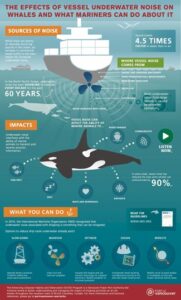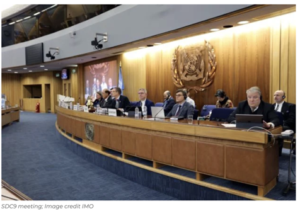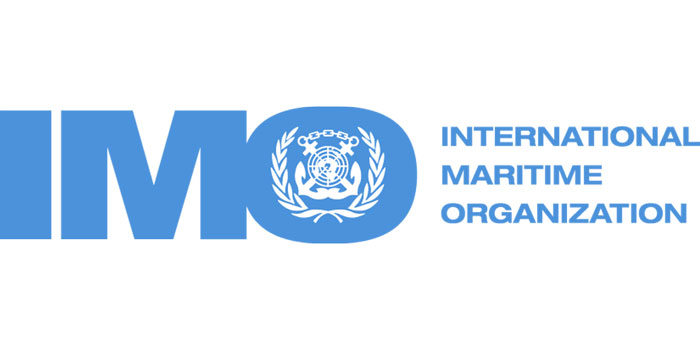2023 has seen momentous developments in Ocean protection. For the first time in 9 years, the International Maritime Organisation (IMO) has updated its guidelines to reduce underwater noise from shipping; the EU has announced an €816.5 million commitment; and the UN are well underway to sign a High Sea Treaty to protect a third of the Ocean by 2030.
It is proven that marine mammals rely on underwater sound to navigate, track food, and locate potential mates. Anthropogenic underwater noise pollution (URN) disrupts these natural patterns. The SDC (IMO Sub-Committee on Ship Design) states:
“commercial shipping is one of the main contributors to underwater radiated noise (URN) which has adverse effects on critical life functions for a wide range of marine life, including marine mammals, fish and invertebrate species, upon which many coastal Indigenous communities depend for their food, livelihoods and cultures.”

Image source: https://www.imo.org/en/MediaCentre/HotTopics/Pages/Noise.aspx
In late January, SDC9 released its review of the IMO’s 2014 Guidelines. The 2014 guidelines focused on primary sources of underwater noise such as propellers, hull form, and onboard machinery; and included various operational and maintenance recommendations. However, due to the complexity of the issue, they did not set future targets for underwater sound levels, stating more research was needed; and were non-mandatory, therefore sparsely implemented. In June 2021 the SDC was tasked to revise them, and identify a program of action moving forward.
The aim of SDC9 has been to provide updated recommendations based on the latest developments in design and technology, and to address potential hurdles to implementation.

The revised guidelines attempt to establish noise management planning as a flexible tool, allowing a customised approach for each individual ship’s design and operation. Given the complexities associated with ship construction and varying ship noise profiles, noise management planning is best undertaken at the earliest design stages; although URN modifications are also possible for existing vessels.
The revised guidelines contain an overview of approaches for designers, shipbuilders and ship operators, to integrate new technologies. They also focus on the relationship between Energy Efficiency Compliance Measures and underwater radiated noise (URN). Many of the improvement options to meet energy regulations (EEDI, EEXI and CII) can also result in an improvement in URN performance.
The Arctic – The Arctic Ocean, also known as the Inuit Nunaat, is becoming increasingly accessible as a sea route due to climate change, with traffic doubling in the past decade. The revised guidelines focus on the region, where anthropogenic URN is especially harmful as sound propagates further in colder waters. Ship URN significantly impacts Arctic marine life and in turn, the Inuit communities that rely on it. There is a call for mandatory and even more stringent measures to be enforced in the region.
Glonoise – In addition to revised implementation methods, SDC9 also prioritises the importance of increased awareness. The Global Partnership for Mitigation of Underwater Noise from Shipping (GloNoise) has been established to: “assist developing countries and regions to raise awareness, to build capacity and to collect information to assist the policy dialogue on anthropogenic underwater noise from shipping”.
In addition to development by the IMO Guideline review, the EU announced €816.5 million commitment to ocean protection at the Our Ocean conference on 2nd March. This includes endorsing a ‘maximum acceptable level’ for URN in marine waters. Regional Sea Conventions will be key in implementing these thresholds on the ground.
And a third major development on 4th March, saw the UN reach a historic agreement – the High Seas Treaty. This is a significant step in progress to establishing Marine Protected Areas (MPA) in 30% of the Ocean by 2030.
So what happens next? The revised IMO guidelines are subject to approval by the Marine Environment Protection Committee (MEPC) in June 2023. We can expect to see increased mainstream dialogue on the subject, and progress towards financially incentivised schemes to support the implementation of URN mitigating technology.
With so many significant developments in ocean conservation and legislation over the past two months, it has never been more pivotal to think-forward, and form strategies to adapt vessels to operate with reduced URN. Our PressurePores™ system developed at Oscar Propulsion has been specifically designed to reduce propeller tip vortex cavitation, and therefore URN. This is achieved by a small number of strategically placed holes within a propeller blade, both on new and retrofit systems.
The world is changing, and the industry will need to catch up. If you’d like to discuss the policy changes and propeller quietening technologies available, please contact us. https://oscarpropulsion.com/work-with-us/
Written for Oscar Propulsion by
